Warburg Micro syndrome is caused by RAB18 deficiency or dysregulation
- PMID: 26063829
- PMCID: PMC4632505
- DOI: 10.1098/rsob.150047
Warburg Micro syndrome is caused by RAB18 deficiency or dysregulation
Abstract
RAB18, RAB3GAP1, RAB3GAP2 and TBC1D20 are each mutated in Warburg Micro syndrome, a rare autosomal recessive multisystem disorder. RAB3GAP1 and RAB3GAP2 form a binary 'RAB3GAP' complex that functions as a guanine-nucleotide exchange factor (GEF) for RAB18, whereas TBC1D20 shows modest RAB18 GTPase-activating (GAP) activity in vitro. Here, we show that in the absence of functional RAB3GAP or TBC1D20, the level, localization and dynamics of cellular RAB18 is altered. In cell lines where TBC1D20 is absent from the endoplasmic reticulum (ER), RAB18 becomes more stably ER-associated and less cytosolic than in control cells. These data suggest that RAB18 is a physiological substrate of TBC1D20 and contribute to a model in which a Rab-GAP can be essential for the activity of a target Rab. Together with previous reports, this indicates that Warburg Micro syndrome can be caused directly by loss of RAB18, or indirectly through loss of RAB18 regulators RAB3GAP or TBC1D20.
Keywords: GAP; GEF; RAB18; Rab; Ras.
Figures
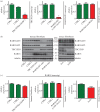
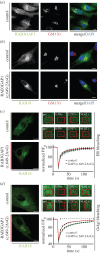
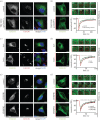
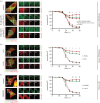
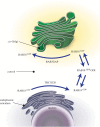
References
-
- Martsolf JT, Hunter AG, Haworth JC. 1978. Severe mental retardation, cataracts, short stature, and primary hypogonadism in two brothers. Am. J. Med. Genet. 1, 291–299. (doi:10.1002/ajmg.1320010305) - DOI - PubMed
-
- Warburg M, Sjo O, Fledelius HC, Pedersen SA. 1993. Autosomal recessive microcephaly, microcornea, congenital cataract, mental retardation, optic atrophy, and hypogenitalism. Micro syndrome. Am. J. Dis. Child. 147, 1309–1312. (doi:10.1001/archpedi.1993.02160360051017) - DOI - PubMed
-
- Aligianis IA, et al. 2005. Mutations of the catalytic subunit of RAB3GAP cause Warburg Micro syndrome. Nat. Genet. 37, 221–223. (doi:10.1038/ng1517) - DOI - PubMed
-
- Bem D, et al. 2011. Loss-of-function mutations in RAB18 cause Warburg Micro syndrome. Am. J. Hum. Genet. 88, 499–507. (doi:10.1016/j.ajhg.2011.03.012) - DOI - PMC - PubMed
-
- Borck G, et al. 2011. A homozygous RAB3GAP2 mutation causes Warburg Micro syndrome. Hum. Genet. 129, 45–50. (doi:10.1007/s00439-010-0896-2) - DOI - PubMed
Publication types
MeSH terms
Substances
Supplementary concepts
Grants and funding
LinkOut - more resources
Full Text Sources
Other Literature Sources
Medical
Molecular Biology Databases
Miscellaneous

